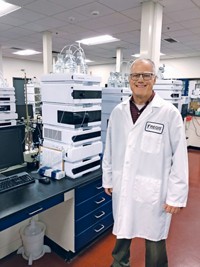Advertisement
Grab your lab coat. Let's get started
Welcome!
Welcome!
Create an account below to get 6 C&EN articles per month, receive newsletters and more - all free.
It seems this is your first time logging in online. Please enter the following information to continue.
As an ACS member you automatically get access to this site. All we need is few more details to create your reading experience.
Not you? Sign in with a different account.
Not you? Sign in with a different account.
ERROR 1
ERROR 1
ERROR 2
ERROR 2
ERROR 2
ERROR 2
ERROR 2
Password and Confirm password must match.
If you have an ACS member number, please enter it here so we can link this account to your membership. (optional)
ERROR 2
ACS values your privacy. By submitting your information, you are gaining access to C&EN and subscribing to our weekly newsletter. We use the information you provide to make your reading experience better, and we will never sell your data to third party members.
Business
Reckoning Day
Liveris' predictions for the fine chemicals industry miss the mark
by Lisa M. Jarvis
March 3, 2008
| A version of this story appeared in
Volume 86, Issue 9
In early 2003, Andrew N. Liveris stood before an audience at the opening of Informex, the annual fine chemicals trade show, and named names.
Liveris, then the president of Dow Chemical's performance chemicals group, said the business of supplying fine chemicals to the pharmaceutical industry would look very different in five years. With profits under pressure, production capacity in oversupply, and competition from Asia growing, Western companies would be forced to consolidate. The survivors would emerge with financial muscle and a broad technology offering that would span both small and large molecules.
He went on to boldly predict that the industry leaders in 2008 would be Akzo Nobel, Avecia, BASF, Degussa, DSM, Lonza, and, of course, Dow. Among the small companies that would survive, he picked firms focused on contract research and process development.
I remember walking out of the double doors of the ballroom after the talk and feeling a hand grasp my arm. It was a contact from Lonza, who looked at me excitedly and exclaimed, "We made the list!"
The cocktail reception that followed Liveris' speech was atwitter with who was in and who was out. It was like a scene out of a junior high school dance, with the popular kids gloating while the wallflowers gazed longingly from the bleachers.
Five years later, some might regret that gloating. Liveris, it turns out, was off the mark.
I can still find my source at Lonza, but the Swiss contract manufacturing firm is the only company on the list that succeeded at offering both small and large molecules. It is also one of the few to contribute to consolidation, acquiring UCB Bioproducts, the peptides manufacturing arm of Belgian drug firm UCB, and buying Cambrex' biopharma and bioproducts business.
BASF is still an industry stalwart, even expanding through the acquisition of Orgamol. Degussa is around, though it is now part of Evonik Industries and has scaled back in North America with the sale of its Raylo Chemicals subsidiary.
DSM made bold statements early in the decade about investing in large molecules at its site in Montreal, but it later backed away from the project. In 2006, the Dutch firm mothballed the facility altogether and shifted its biologics focus to cell-line technology. At the same time, DSM sold its pharmaceutical chemicals plant in South Haven, Mich., to Albemarle.
Dowpharma took a similar tack to DSM. In 2004, it closed a fermentation plant in Smithfield, R.I., abandoning earlier ambitions to get into commercial-scale biologics manufacturing and focusing instead on its technology offerings.
Akzo Nobel, meanwhile, let go of its biologics arm, Diosynth, when it sold Organon Biosciences to Schering-Plough. And Avecia, which had made major investments in both small- and large-molecule capabilities, sold its small-molecule business to Nicholas Piramal India Ltd. and is today just a shadow of its former self.
So why did reality end up so far from Liveris' vision? Although times were tough for the fine chemicals industry in 2003, companies were banking on customers having bursting new drug pipelines. That didn't pan out. With last year's 24-year low in approvals of new molecular entities, few launches of major biologics, several product withdrawals, and a tidal wave of cost-cutting programs, there's simply less work to go around. Drug companies are looking to trim costs, and their suppliers are feeling the squeeze.
Furthermore, no one could have predicted in 2003 just how swiftly Indian firms would penetrate the industry. Taking advantage of the downturn among U.S. and European fine chemicals makers, India's Nicholas Piramal, Shasun, and Dishman Pharmaceuticals & Chemicals all managed to acquire assets on the cheap. Rather than the predicted wave of consolidation, the players and geographies simply changed.
In the new era of tighter profit margins and fierce competition for projects come new strategies. In the past several years, many surviving companies have sought to establish links to low-cost production in China or India.
Interestingly, one theme emerging in the fine chemicals industry is diversification. But instead of branching into large molecules, as Liveris predicted in 2003, companies are now mitigating risk by looking beyond pharmaceuticals. Sigma-Aldrich's SAFC division, for example, is getting into electronic chemicals and flavor and fragrance ingredients to balance any downturn in the other industries the company serves. Albemarle has maintained a presence in agricultural chemicals, which didn't seem sexy in the pharma heyday but are becoming lucrative as the farm belt booms.
At this year's Informex, an informal survey of companies and consultants suggests there may be a different crop of leaders in 2013. I asked which companies could weather a weak drug pipeline, which had the flexibility to supply smaller volumes of more potent and targeted drugs, and which had the technological edge over low-cost Asian suppliers. Insiders and observers alike named Albemarle, BASF, Lonza, and the Italian firm FIS as poised for long-term success. Among the smaller companies to watch, several people identified Chinese firms.
Liveris' crystal ball might have been cloudy that day in 2003, but he can take comfort. After all, his title has since been upgraded to president, chairman, and chief executive officer of Dow.
Views expressed on this page are those of the author and not necessarily those of ACS.





Join the conversation
Contact the reporter
Submit a Letter to the Editor for publication
Engage with us on Twitter